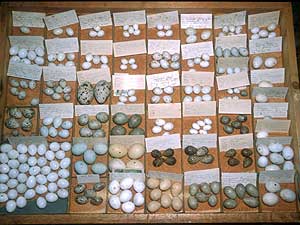|
Audio
Photos
|
May 20, 2005
Carrol Henderson recently came across an unusual collection stashed in an old farmhouse - thousands of bird eggs. Henderson runs the Minnesota DNR's non-game wildlife program. He says this collection can tell us about birds that lived 100 years ago - and about what birds need from us today.
Duluth, Minn. — Carrol Henderson grew up on a farm in central Iowa.
Last summer he learned that a family in his old neighborhood was renovating a farmhouse. It had belonged to Ralph Handsaker. When he died 30 years ago, the house was boarded up and left alone. But when Handsaker's great-grandson decided to move into the house, the renovations uncovered a lifetime of collections of a nature lover. "Along with a number of old animal mounts and interesting things, there were these two large chests with about 15 drawers each, that were totally filled with little sets of wild bird eggs," says Henderson.
There were more than 3,600 eggs, representing more than 400 species of birds from all over the world. And they were in perfect condition.
"Each set of eggs was very neatly labeled with information about the day they were collected, who the collector was, and information about the habitat where the egg was collected," Henderson says. "Some of these went all the way back to 1875, and they were collected by over 300 different people from all over the world."
This is how nature-lovers expressed their passion in those days. They called themselves oologists. (It's pronounced oh-ologists.) They kept their eggs in drawers lined with cedar sawdust to protect them from insects. They also kept meticulous records.
"So the scientific data was very high quality among these avid collectors," Henderson says. "Even today, these provide very important nest records for birds that are gone. Like in my home county of Story County, Iowa, there were marble godwits, king rails, prairie chickens, and bobwhite quail. And those are all gone now."
The birds disappeared as people turned prairies into farms. But the records in the bird collection provide detailed information about where and when they nested.
"And another intriguing thing is that when these people blew out the eggs, there was still a lining of the egg white or albumen inside the egg," Henderson says. "And that still has the original DNA genetic material, so it actually would be possible for scientists to do DNA analysis of these eggs, to take a look at how they may compare with birds nowadays."
Henderson says these collectors didn't think they were harming the birds. That's because if their eggs disappear, most birds will lay another set. But competition for the eggs of rare birds was disastrous for the birds.
"One person in Philadelphia had a collection of over 700 peregrine falcon eggs," says Henderson. "Another peregrine egg collector went to the same cliff and collected all the eggs from the peregrines every year for 29 consecutive years. And finally the nest was abandoned. And he said it was abandoned due to encroaching civilization! That was where egg collecting really had something of a dark side."
Eventually, attitudes began to change. In 1918 the federal government passed the Migratory Bird Treaty Act, to protect birds and eggs. But three collectors were allowed to carry on. One of them was Ralph Handsaker. So his collection goes into the early 1950s.
Carrol Henderson says there's a lot to learn from these eggs. One of the best lessons is about human responsibility. Henderson says people enjoy nature differently than we did a hundred years ago. But we shouldn't be too smug.
"We need to be doing things today that will leave a lasting impact for those people a hundred years from now who will look back on us -- and they may wonder what were we thinking -- like we look back on these early egg collectors," Henderson says. "And I think we have an opportunity to really make a difference with our conservation programs in Minnesota."
Carrol Henderson's article about the Handsaker egg collection will appear in the October issue of Birders World magazine. The Handsaker family is planning to donate the collection to a major university.








